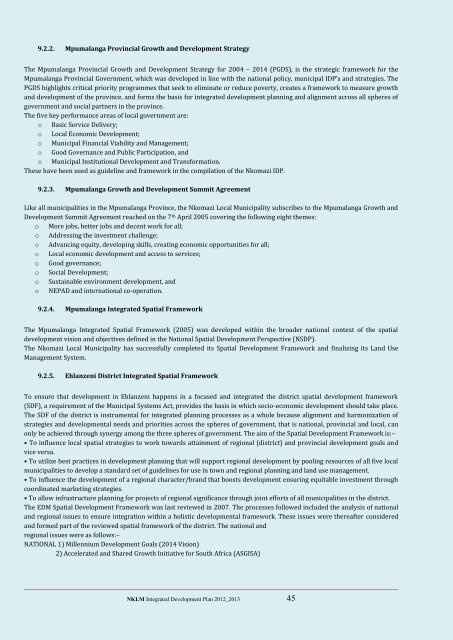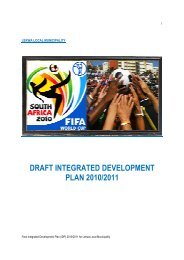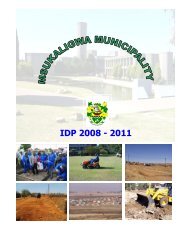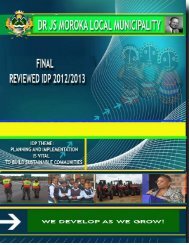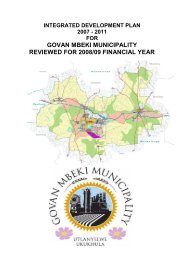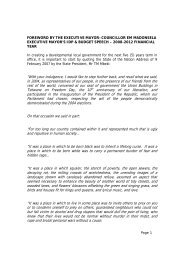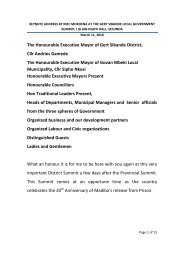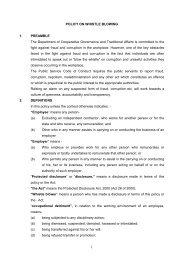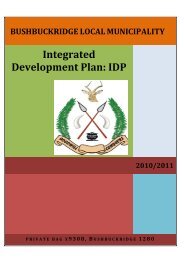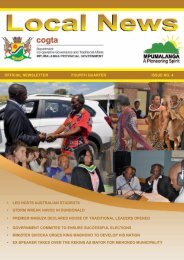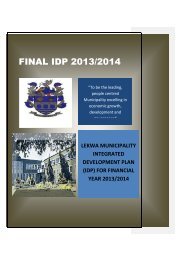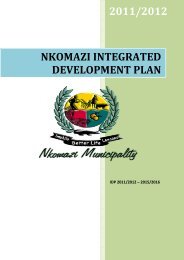Nkomazi Local Municipality 20 - Co-operative Governance and ...
Nkomazi Local Municipality 20 - Co-operative Governance and ...
Nkomazi Local Municipality 20 - Co-operative Governance and ...
- No tags were found...
Create successful ePaper yourself
Turn your PDF publications into a flip-book with our unique Google optimized e-Paper software.
9.2.2. Mpumalanga Provincial Growth <strong>and</strong> Development StrategyThe Mpumalanga Provincial Growth <strong>and</strong> Development Strategy for <strong>20</strong>04 – <strong>20</strong>14 (PGDS), is the strategic framework for theMpumalanga Provincial Government, which was developed in line with the national policy, municipal IDP’s <strong>and</strong> strategies. ThePGDS highlights critical priority programmes that seek to eliminate or reduce poverty, creates a framework to measure growth<strong>and</strong> development of the province, <strong>and</strong> forms the basis for integrated development planning <strong>and</strong> alignment across all spheres ofgovernment <strong>and</strong> social partners in the province.The five key performance areas of local government are:o Basic Service Delivery;o <strong>Local</strong> Economic Development;o Municipal Financial Viability <strong>and</strong> Management;o Good <strong>Governance</strong> <strong>and</strong> Public Participation, <strong>and</strong>o Municipal Institutional Development <strong>and</strong> Transformation.These have been used as guideline <strong>and</strong> framework in the compilation of the <strong>Nkomazi</strong> IDP.9.2.3. Mpumalanga Growth <strong>and</strong> Development Summit AgreementLike all municipalities in the Mpumalanga Province, the <strong>Nkomazi</strong> <strong>Local</strong> <strong>Municipality</strong> subscribes to the Mpumalanga Growth <strong>and</strong>Development Summit Agreement reached on the 7 th April <strong>20</strong>05 covering the following eight themes:o More jobs, better jobs <strong>and</strong> decent work for all;o Addressing the investment challenge;o Advancing equity, developing skills, creating economic opportunities for all;o <strong>Local</strong> economic development <strong>and</strong> access to services;o Good governance;o Social Development;o Sustainable environment development, <strong>and</strong>o NEPAD <strong>and</strong> international co-operation.9.2.4. Mpumalanga Integrated Spatial FrameworkThe Mpumalanga Integrated Spatial Framework (<strong>20</strong>05) was developed within the broader national context of the spatialdevelopment vision <strong>and</strong> objectives defined in the National Spatial Development Perspective (NSDP).The <strong>Nkomazi</strong> <strong>Local</strong> <strong>Municipality</strong> has successfully completed its Spatial Development Framework <strong>and</strong> finalizing its L<strong>and</strong> UseManagement System.9.2.5. Ehlanzeni District Integrated Spatial FrameworkTo ensure that development in Ehlanzeni happens in a focused <strong>and</strong> integrated the district spatial development framework(SDF), a requirement of the Municipal Systems Act, provides the basis in which socio-economic development should take place.The SDF of the district is instrumental for integrated planning processes as a whole because alignment <strong>and</strong> harmonization ofstrategies <strong>and</strong> developmental needs <strong>and</strong> priorities across the spheres of government, that is national, provincial <strong>and</strong> local, canonly be achieved through synergy among the three spheres of government. The aim of the Spatial Development Framework is:–• To influence local spatial strategies to work towards attainment of regional (district) <strong>and</strong> provincial development goals <strong>and</strong>vice versa.• To utilize best practices in development planning that will support regional development by pooling resources of all five localmunicipalities to develop a st<strong>and</strong>ard set of guidelines for use in town <strong>and</strong> regional planning <strong>and</strong> l<strong>and</strong> use management.• To influence the development of a regional character/br<strong>and</strong> that boosts development ensuring equitable investment throughcoordinated marketing strategies.• To allow infrastructure planning for projects of regional significance through joint efforts of all municipalities in the district.The EDM Spatial Development Framework was last reviewed in <strong>20</strong>07. The processes followed included the analysis of national<strong>and</strong> regional issues to ensure integration within a holistic developmental framework. These issues were thereafter considered<strong>and</strong> formed part of the reviewed spatial framework of the district. The national <strong>and</strong>regional issues were as follows:–NATIONAL 1) Millennium Development Goals (<strong>20</strong>14 Vision)2) Accelerated <strong>and</strong> Shared Growth Initiative for South Africa (ASGISA)NKLM Integrated Development Plan <strong>20</strong>12_<strong>20</strong>13 45


